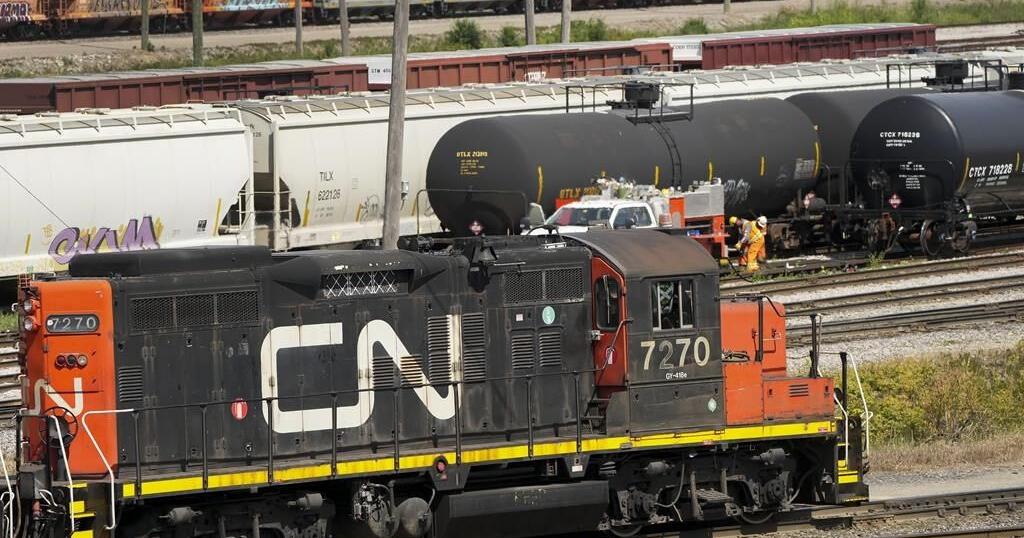MONTREAL – The country’s two main freight railways are turning away a growing number of goods ahead of a potential work stoppage next week that could disrupt supply chains and industry.
Canadian National Railway Co. schedules show that, starting Friday, it barred container imports from U.S. partner railways. After this Wednesday, no more of the 40,000 containers CN hauls each week will be received — regardless of origin — according to another timetable.
CN and Canadian Pacific Kansas City Ltd. have also halted shipments that need cooler temperatures, such as meat and medicine, to avoid seeing stranded loads go bad should a work stoppage occur.
Railways carry more than $1 billion worth of goods each day, according to the Railway Association of Canada. More than half of the country’s exports travel by rail.
The two rail companies have warned that 9,300 engineers, conductors and yard workers will be locked out at 12:01 a.m. on Thursday unless they can reach new collective agreements, while the union has also said it is poised for a strike.
Both sides returned to the bargaining table last week amid an ongoing deadlock over scheduling and wages, with shipments of chlorine for drinking water already halted as part of a phased shutdown poised to progress even further next week.
Federal Labour Minister Steven MacKinnon on Thursday rejected a request from CN to impose binding arbitration as the negotiating clock ticks down.
Industry players, including chemical producers, are growing more alarmed by the day.
“We’re already in a strike for chlorine,” said Alan Robinson, commercial vice-president at Chemtrade Logistics Inc. The Toronto company says it provides chlorine for 40 per cent of Western Canada’s drinking water, as well as much of the western United States.
Its product cannot move by truck or ship, he pointed out, and safety regulations cap the amount that can be stockpiled.
However, Metro Vancouver said it is prepared, having topped up its tanks “to maximum levels,” with plenty of bleach on hand at plants in the region.
“Metro Vancouver does not foresee any disruptions to the drinking water treatment process as a result of potential supply chain issues,” said spokeswoman Jennifer Saltman.
The White House and U.S. Environmental Protection Agency both reached out to Chemtrade this week with concerns about municipal water treatment, Robinson said.
“You’re looking at seven to 10 days once they don’t have shipments before they’re in trouble,” added Bob Masterson, CEO at the Chemistry Industry Association of Canada. Most municipalities also have a few more days’ worth of treated water in storage tanks, he noted.
A COMPLICATED WIND-DOWN
Both railways began a complex process of putting the brakes on freight flows this week.
After Friday, no refrigerated containers will be allowed into CPKC terminals — from Vancouver to Saint John, N.B., to Laredo, Texas — according to a “wind-down schedule” obtained by The Canadian Press.
This week, CN partner Norfolk Southern Railway told clients it would close its gates to all Canadian-bound containers effective Friday morning.
CPKC has also broadened its ban on hazardous materials shipments.
It stopped accepting boxes loaded with dangerous goods on Thursday, a customer notice states.
As of Saturday, the company is rejecting a range of “security-sensitive” materials, such as fertilizer chemicals and styrene — used to manufacture everything from insulation to auto parts. The embargo expands on a ban on poisonous and toxic inhalation substances from earlier in the week.
“There really aren’t very many industries that are immune to this. Commodities, mining, forestry, agriculture, chemicals, automotive, electronics,” said Fraser Johnson, a professor at Western University’s Ivey Business School specializing in supply chains.
“Farmers, consumers … then you’ve got all the workers in the plant that are affected by the strike or the lockout,” he said. “There’s just no Plan B.”
Contracting semi trucks to replace the roughly 41,000 carloads that CN and CPKC move daily is far from feasible, he added.
HARVEST SEASON
The possible work stoppage looms just as harvest season dawns, worrying farmers and wholesalers.
Pulse crops — beans, peas, lentils — are some of the first to be gathered, followed by canola and wheat. A shipping halt could have ripple effects well into the fall.
“You just have this buildup of the various crops not being able to go anywhere,” said Greg Northey, an executive at Pulse Canada, who said every day of delay requires several to recover.
Karen Proud, CEO of Fertilizer Canada, framed the threat of a stoppage as a question of national reputation.
The 13-day strike by 7,400 B.C. dockworkers last summer prompted some potash customers to opt for other suppliers, including Russia.
“And we have not necessarily gotten all of that back. For every dollar that we lose in potash sales, those dollars go to Russia or Belarus,” she said.
Proud cautioned that after rail, seaway and port strikes in 2012, 2015, 2019, 2021, 2022 and 2023, Canada could “lose our reputation” among customers.
“If they can’t count on getting these products in time when they need it, they’re going to look elsewhere,” she said.
This report by The Canadian Press was first published Aug. 16, 2024.
Companies in this story: (TSX:CP, TSX:CNR)
